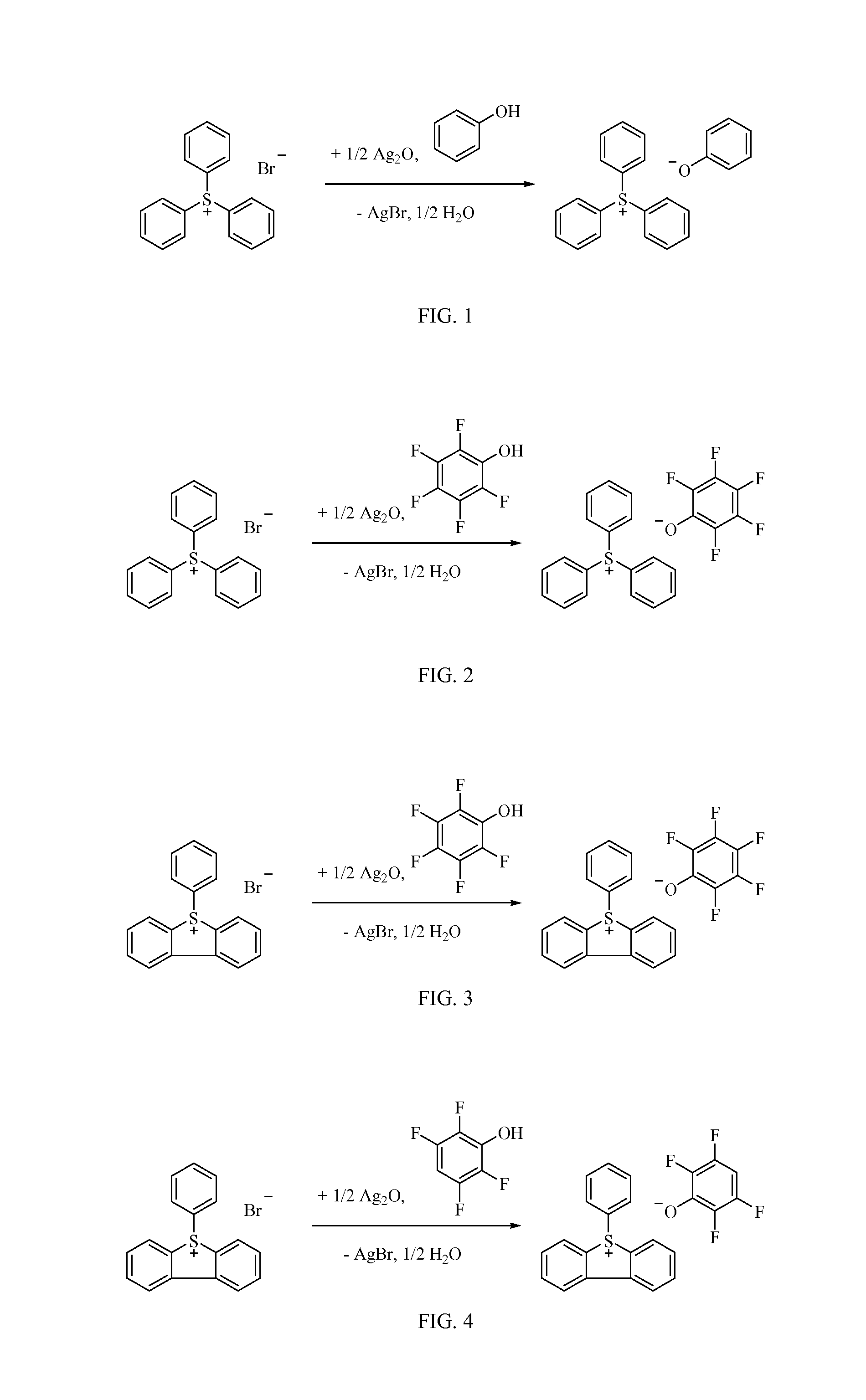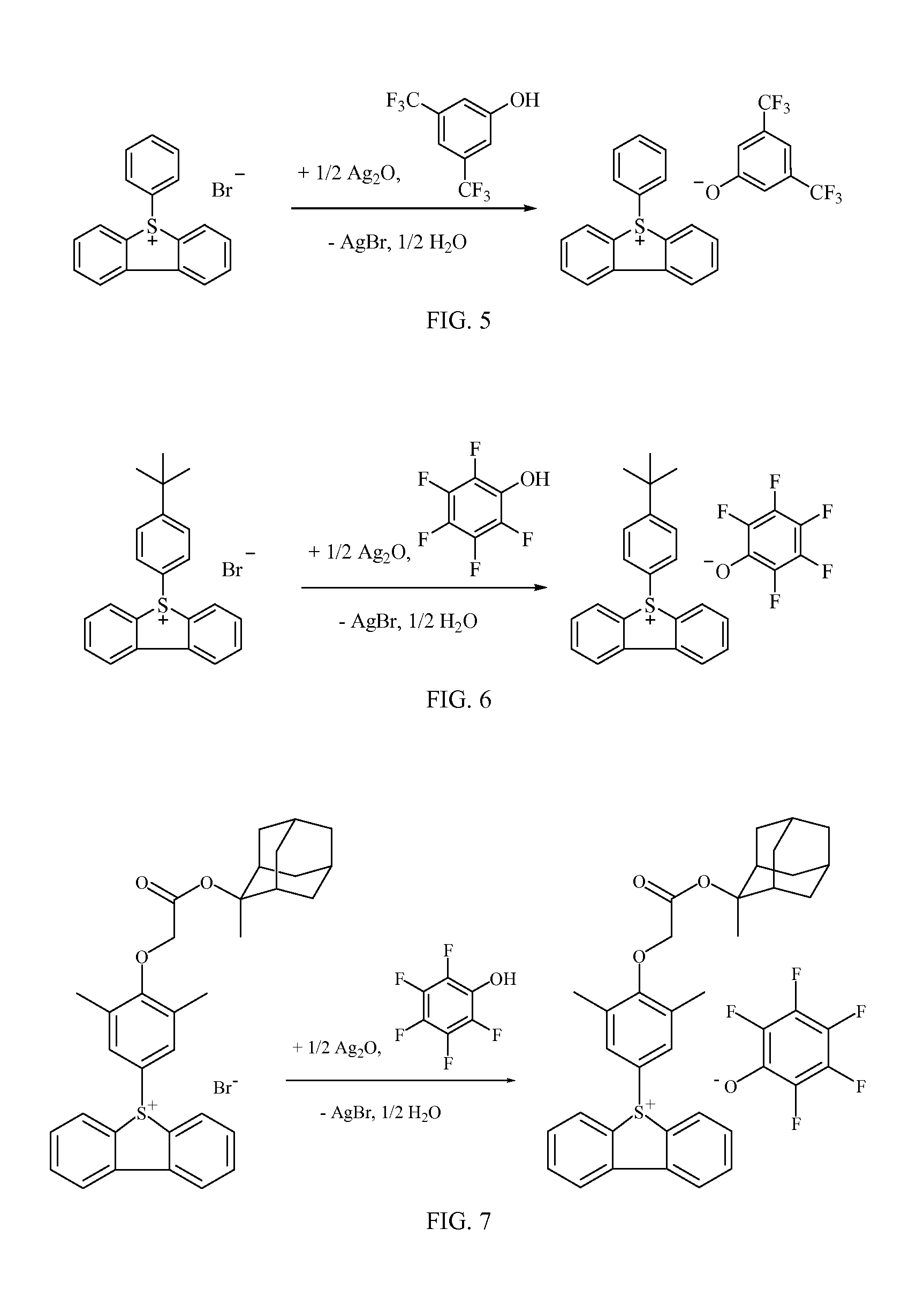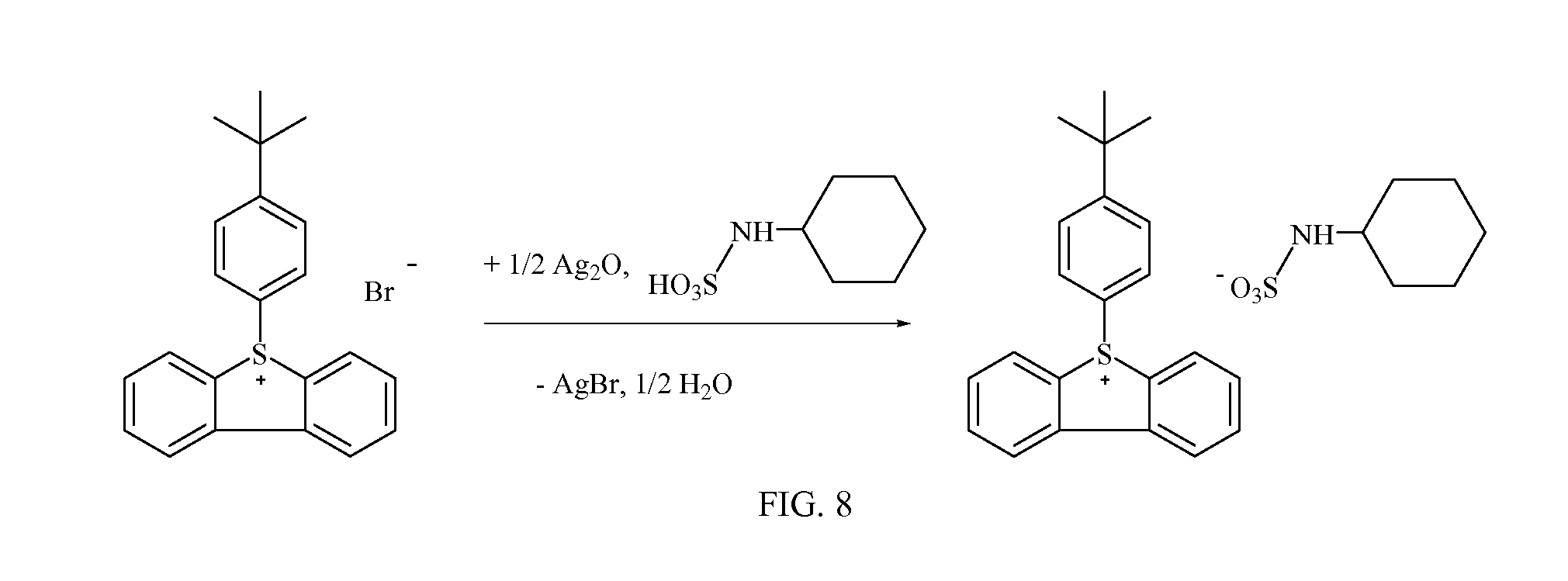Photo-destroyable quencher and associated photoresist composition, and device-forming method
a technology of photoresist polymer and quencher, which is applied in the field of photodestroyable quenchers, can solve the problems of acid generated by photo-destroyable quenchers that is not strong enough to react quickly with acid-sensitive groups on the photoresist polymer, and the neutralization of strong acid in the unexposed region
- Summary
- Abstract
- Description
- Claims
- Application Information
AI Technical Summary
Benefits of technology
Problems solved by technology
Method used
Image
Examples
example 4
5-Phenyl-5H-dibenzo[b,d]thiophen-5-ium 3,5-bis(trifluoromethyl)-phenolate
[0051]The reaction is summarized in FIG. 5. Silver oxide (3.57 grams, 15.4 millimoles) was added to a solution of 5H-dibenzo[b,d]thiophen-5-ium bromide (5.00 grams, 14.7 millimoles) in methanol (50 milliliters) and stirred overnight. The reaction mixture was filtered through CELITE™, which was washed with methanol (50 milliliters) and the organic layers combined. 3,5-bis(trifluoromethyl)phenol (3.37 grams, 14.7 millimoles) was then added and stirred at room temperature for 4 hours. The solution was concentrated to an oil which was suspended in MTBE:heptanes (1:1, 250 milliliters) and vigorously stirred overnight. The solid was filtered and washed with MTBE (2×200 milliliters) to afford 5-phenyl-5H-dibenzo[b,d]thiophen-5-ium 3,5-bis(trifluoromethyl)-phenolate (3.05 grams, 42%) as a white solid. 1H NMR (300 MHz, (CD3)2SO) δ: 8.53 (d, J=7.8 Hz, 2H), 8.41 (d, J=7.8 Hz, 2H), 7.96 (t, J=7.8 Hz, 2H), 7.76 (t, J=8.1 Hz...
example 5
5-(4-(tert-Butyl)phenyl)-5H-dibenzo[b,d]thiophen-5-ium 2,3,4,5,6-pentafluorophenolate
[0052]The reaction is summarized in FIG. 6. Silver oxide (2.45 grams, 10.6 millimoles) was added to a solution of 5-(4-(tert-butyl)phenyl)-5H-dibenzo[b,d]thiophen-5-ium bromide (4.00 grams, 10.1 millimoles) in methanol (50 milliliters) and stirred overnight. The reaction mixture was filtered through CELITE™, which was washed with methanol (50 milliliters) and the organic layers combined. Tetrafluorophenol (1.85 grams, 10.1 millimoles) was then added and stirred at room temperature for 4 hours. The solution was concentrated to an oil which was precipitated into MTBE:heptanes (1:1, 250 milliliters). The solid was filtered and washed with MTBE (2×200 milliliters) to afford 5-(4-(tert-butyl)phenyl)-5H-dibenzo[b,d]thiophen-5-ium 2,3,4,5,6-pentafluorophenolate (4.66 grams, 92%) as a white solid. 1H NMR (300 MHz, (CD3)2SO) δ: 8.53 (d, J=7.8 Hz, 2h), 8.38 (d, J=7.8 Hz, 2H), 7.96 (t, J=8.1 Hz, 2H), 7.76 (t, ...
example 6
5-(3,5-Dimethyl-4-(2-(((1R,3S,5r,7r)-2-methyladamantant-2-yl)oxy)-2-oxoethoxy)phenyl)-5H-dibenzo[b,d]thiophen-5-ium 2,3,4,5,6-pentafluorophenolate
[0053]The reaction is summarized in FIG. 7. Silver oxide (2.22 grams, 9.60 millimoles) was added to a solution of 5-(3,5-dimethyl-4-(2-(((1R,3S,5r,7r)-2-methyladamantant-2-yl)oxy)-2-oxoethoxy)phenyl)-5H-dibenzo[b,d]thiophen-5-ium chloride (5.00 grams, 9.14 millimoles) and pentafluorophenol (1.77 grams, 9.60 millimoles) in methanol (100 milliliters) and stirred at room temperature for 4 hours. The reaction mixture was filtered through CELITE™, which was washed with methanol (100 milliliters), the organic layers combined and concentrated to a viscous oil which was dissolved in minimal acetone which was then fully dissolved in MTBE (250 milliliters) and vigorously stirred overnight. The resulting brown solids were discarded and the mother liquor concentrated to about 20 milliliters which was precipitated into MTBE:heptanes (2:3, 250 millilite...
PUM
| Property | Measurement | Unit |
|---|---|---|
| Hygroscopicity | aaaaa | aaaaa |
| Structure | aaaaa | aaaaa |
| Sensitivity | aaaaa | aaaaa |
Abstract
Description
Claims
Application Information
 Login to View More
Login to View More - R&D
- Intellectual Property
- Life Sciences
- Materials
- Tech Scout
- Unparalleled Data Quality
- Higher Quality Content
- 60% Fewer Hallucinations
Browse by: Latest US Patents, China's latest patents, Technical Efficacy Thesaurus, Application Domain, Technology Topic, Popular Technical Reports.
© 2025 PatSnap. All rights reserved.Legal|Privacy policy|Modern Slavery Act Transparency Statement|Sitemap|About US| Contact US: help@patsnap.com



